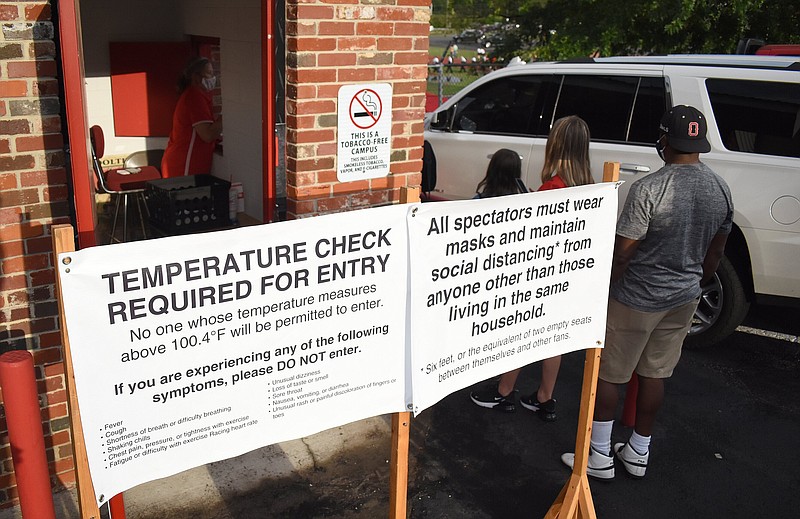Many Hamilton County Schools with the most COVID-19 closures thus far are among the schools with the lowest percentages of students learning in-person this semester, according to a Times Free Press review of school data.
The Times Free Press analyzed fall enrollment numbers from the district to determine if campuses that had higher percentages of students select in-person learning were more likely to experience a COVID-19 closure, which occurs when a positive case is identified.
So far, the schools with more than 90% of their students attending in-person have experienced no closures, whereas the schools with the most closures - Chattanooga School for the Arts and Sciences Upper, Red Bank High School, Ooltewah High School and The Howard School - have roughly 50% of their student body attending virtually.
In addition, Ooltewah High and Red Bank High each underwent a week of hybrid learning this fall in order to reduce the number of students in the classroom with hopes of slowing the spread of COVID-19.
Jen Bronson, lead COVID-19 response coordinator for the district, said by email that she can't say why those particular schools have been hardest hit by closures, because she "can't share specifics of any case."
However, research indicates that children age 10 and older transmit COVID-19 more readily than younger children. Dr. Allen Coffman, a pediatrician at Highland Pediatrics in Hixson, said that may explain in part why elementary schools generally are seeing a smaller proportion of coronavirus closures than middle and high schools.
"The bigger the kids are, the more problems they're having, and even cutting the amount of people at the school down a lot doesn't seem to have a big difference based on this data," Coffman said.
Across the district, there are 40 elementary schools, 18 middle schools and 19 high schools.
Of those schools, 13 elementary schools have experienced at least one closure, compared to 9 middle schools and 14 high schools, according to data provided by the school district and released through social media or other means.
The only high schools that haven't closed at least once so far are Central High School, Ivy Academy, Hamilton County Collegiate High at Chatt State, Chattanooga Girls Leadership Academy, East Ridge High School and Chattanooga High Center for Creative Arts.
School and health officials have repeatedly said that the majority of COVID-19 cases are linked to non-classroom activities, such as social gatherings, athletics and carpooling.
But to really understand exposure events, the district would need to provide more details about the individual cases and the environment, such as the number of students in the classroom, the square footage of the rooms and the ventilation of the buildings, Coffman said.
For example, the risk of contracting coronavirus increases in poorly ventilated indoor spaces and decreases outside, which could explain why Ivy Academy - known for outdoor learning - has not been forced to close despite having the highest percentage of in-person students.
Tyner Academy, which has the highest percentage of virtual students of any school in the district with only 36% of its student body participating in person, has closed three times.
Other factors affecting closures could include how diligently the school is monitoring students and whether everyone is practicing wearing face masks, hand hygiene and social distancing.
Some schools could be closing more simply because the staff is being especially conscientious about monitoring and contact tracing, Coffman said. And the community should expect to see more cases crop up in schools as cases continue to surge.
"The problem is, as your local rates go up, the odds that someone in the room will have [COVID-19] are going to get worse," he said.
Jim Boles, K-12 principal at Chattanooga School for the Arts and Sciences, said that many of the schools' closures came earlier in the semester, when staff and families were still learning how to effectively contact trace as well as the protocols for COVID-19 testing and quarantine.
"As we gain experience in contact tracing and cleaning, we are able to complete the process faster, and need to close buildings for cleaning and contact tracing less often," Boles said, adding that many different factors come into play when deciding to close a school.
"When it comes down to it, I think the district looks at it from a case-by-case basis as to closing, how long you're going to close and what the situation is," he said. " The original plan of how we respond to COVID is more of a living document than a declaration."
As the Nov. 20 deadline to choose spring semester learning options approaches, Boles said parents should remember that if they choose the in-person learning option, they are able to change to virtual learning should the pandemic worsen. However, those who choose virtual learning are locked in for the semester.
"I think people are really counting on that ability to step back to the at-home choice should they feel the need," he said, adding that he's anticipating slightly more interest in in-person learning in the spring.
Boles said the fact that only about 50% of the upper school is enrolled in person has enabled the school to spread students out more.
"I don't know how we'd appropriately social distance if we had 70% of students in person," he said, "which is a concern moving into the second semester."
Contact Elizabeth Fite at efite@timesfreepress.com or follow her on Twitter @ecfite.
